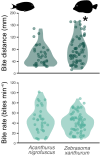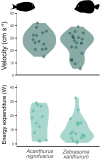Herbivorous fish feeding dynamics and energy expenditure on a coral reef: Insights from stereo-video and AI-driven 3D tracking
- PMID: 38435013
- PMCID: PMC10909578
- DOI: 10.1002/ece3.11070
Herbivorous fish feeding dynamics and energy expenditure on a coral reef: Insights from stereo-video and AI-driven 3D tracking
Abstract
Unveiling the intricate relationships between animal movement ecology, feeding behavior, and internal energy budgeting is crucial for a comprehensive understanding of ecosystem functioning, especially on coral reefs under significant anthropogenic stress. Here, herbivorous fishes play a vital role as mediators between algae growth and coral recruitment. Our research examines the feeding preferences, bite rates, inter-bite distances, and foraging energy expenditure of the Brown surgeonfish (Acanthurus nigrofuscus) and the Yellowtail tang (Zebrasoma xanthurum) within the fish community on a Red Sea coral reef. To this end, we used advanced methods such as remote underwater stereo-video, AI-driven object recognition, species classification, and 3D tracking. Despite their comparatively low biomass, the two surgeonfish species significantly influence grazing pressure on the studied coral reef. A. nigrofuscus exhibits specialized feeding preferences and Z. xanthurum a more generalist approach, highlighting niche differentiation and their importance in maintaining reef ecosystem balance. Despite these differences in their foraging strategies, on a population level, both species achieve a similar level of energy efficiency. This study highlights the transformative potential of cutting-edge technologies in revealing the functional feeding traits and energy utilization of keystone species. It facilitates the detailed mapping of energy seascapes, guiding targeted conservation efforts to enhance ecosystem health and biodiversity.
Keywords: artificial intelligence; functional traits; metabolic traits; movement ecology; surgeonfish.
© 2024 The Authors. Ecology and Evolution published by John Wiley & Sons Ltd.
Figures









Similar articles
-
Morphological and ecological trait diversity reveal sensitivity of herbivorous fish assemblages to coral reef benthic conditions.Mar Environ Res. 2020 Dec;162:105102. doi: 10.1016/j.marenvres.2020.105102. Epub 2020 Aug 6. Mar Environ Res. 2020. PMID: 32814268
-
Individual-based analyses reveal limited functional overlap in a coral reef fish community.J Anim Ecol. 2014 May;83(3):661-70. doi: 10.1111/1365-2656.12171. Epub 2014 Jan 27. J Anim Ecol. 2014. PMID: 24164060
-
Identity of coral reef herbivores drives variation in ecological processes over multiple spatial scales.Ecol Appl. 2019 Jun;29(4):e01893. doi: 10.1002/eap.1893. Epub 2019 Apr 26. Ecol Appl. 2019. PMID: 31026114
-
[Metamorphosis of marine fish larvae and thyroid hormones].Biol Aujourdhui. 2019;213(1-2):27-33. doi: 10.1051/jbio/2019010. Epub 2019 Jul 5. Biol Aujourdhui. 2019. PMID: 31274100 Review. French.
-
The hidden half: ecology and evolution of cryptobenthic fishes on coral reefs.Biol Rev Camb Philos Soc. 2018 Nov;93(4):1846-1873. doi: 10.1111/brv.12423. Epub 2018 May 7. Biol Rev Camb Philos Soc. 2018. PMID: 29736999 Review.
Cited by
-
Ecological Insights From Camera Trapping Span Biological Taxa, and the Globe.Ecol Evol. 2025 Feb 2;15(2):e70947. doi: 10.1002/ece3.70947. eCollection 2025 Feb. Ecol Evol. 2025. PMID: 39901889 Free PMC article.
References
-
- Barrelet, C. , Chaumont, M. , & Subsol, G. (2023). Automatic coral reef fish identification and 3D measurement in the wild. arXiv. 10.48550/arXiv.2312.07357 - DOI
-
- Bates, D. , Mächler, M. , Bolker, B. , & Walker, S. (2015). Fitting linear mixed‐effects models using lme4. Journal of Statistical Software, 67, 1–48. 10.18637/jss.v067.i01 - DOI
-
- Bellwood, D. R. , Streit, R. P. , Brandl, S. J. , & Tebbett, S. B. (2019). The meaning of the term ‘function’ in ecology: A coral reef perspective. Functional Ecology, 33, 948–961. 10.1111/1365-2435.13265 - DOI
LinkOut - more resources
Full Text Sources

